Maksaneethsa, the flapping fan bell: A sacred ornament in Christian Liturgy
Revival of Maksaneethsa, the flapping fan bell in divine liturgy in Syro Malabar church
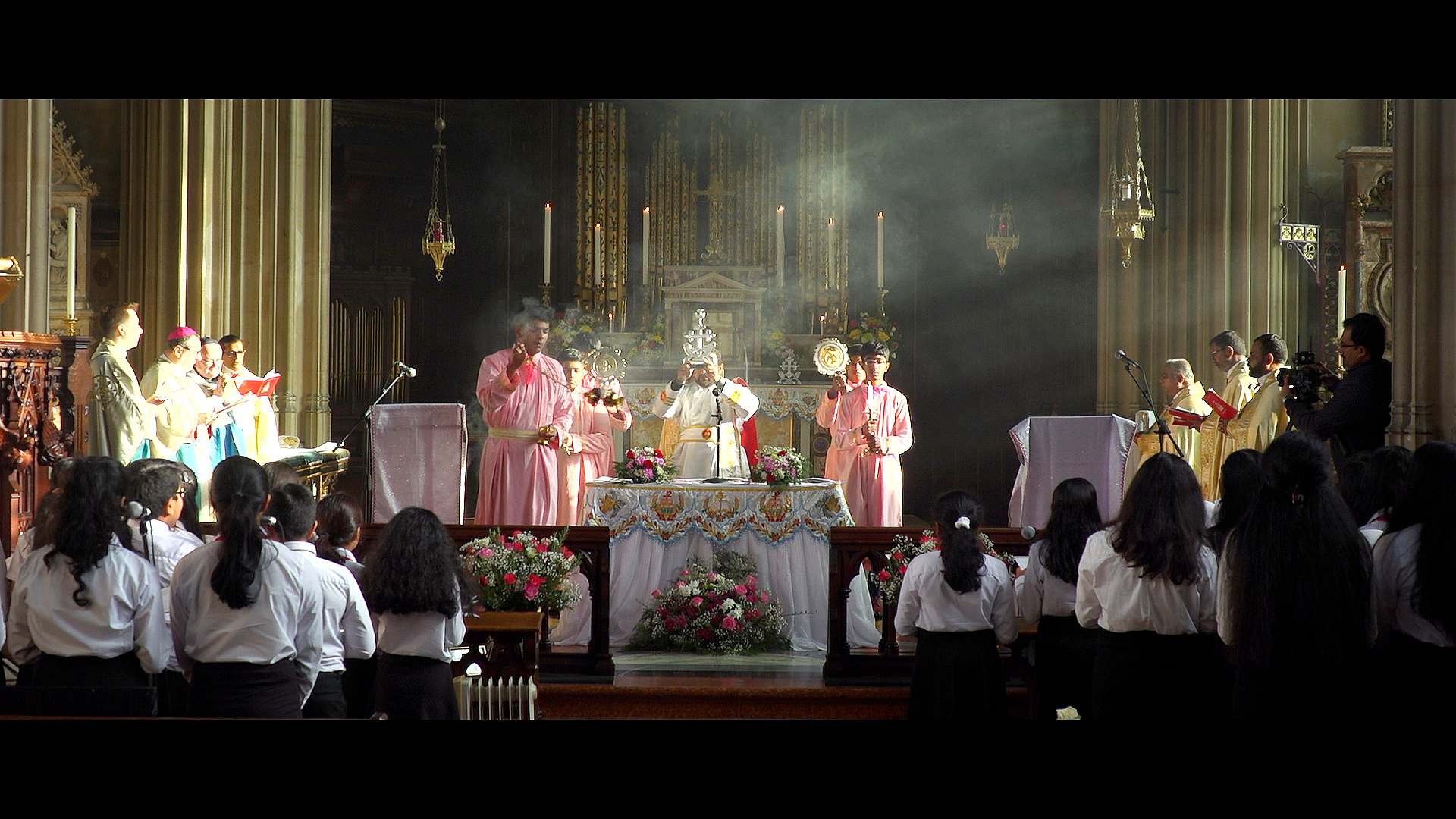
Picture credits Adarash Kurian St Michaels Abbey Farnborough, England 04 December 2021
Maksaneethsa, the flapping fan bell: A sacred ornament in Christian Liturgy
Dr Martin Thomas Antony Pathinaril, Dr Febin George Mookkamthadathil
Introduction
Christian Liturgy involves prayers and worship, and their external expressions[1]. According to the Cambridge English dictionary, Worship is defined as ‘to have or show a strong feeling of respect and admiration for God’[2]. Liturgy involves ceremonies and rituals to show respect and admiration[3].
There are several objects used to express the experience of worship in liturgical celebrations. These include incense, bells, flabella or maksaneethsa, vestments, cross, candle lights etc. These have historical, natural, mystic or symbolic reasons[4] and ceremonial and practical purposes.
Many of these ceremonies and rituals evolved gradually out of certain acts or objects used for practical purposes when certain symbolic or mystic explanations were attributed to them. Maksaneethsa or the liturgical flapping fan bell was evolved in the early church as a flapping fan to drive away insects from the Holy bread and wine to a ceremonial nature as a symbolic representation of angels Seraphim and Cherubim flapping their wings over the Holy altar during the Liturgy. The flapping fans were added with small bells on the periphery to add sound[5]. The bell-ringing gives an audible connection of faithful with a liturgical event calling for spiritual union with prayer and sacrificial offering during the most important moments in Liturgical worship[6].
These flapping fan bells had been widely used in the early church both in the west and the east. In Latin, it is called flabellum[7] and in Greek, rhipidion[8]. In east Syriac, it is called maksaneethsa[9] and in west Syriac, marwha, marwahta[10] or marwahoto[11]. In Armenian tradition, it is called Keshotz[12]. The ceremonial flabellum used before the Pope of Rome in processions is called muscatorium[13].
Etymology
The word meaning of maksaneethsa is fanning or waving as of driving away of insects. The term maksaneethsa came from the East Syriac verb kash. The verb kash in its aphel conjugation means to scare away or drive off. This verb is used in genesis XV: 11 to describe Abraham driving off birds from the sacrifices. The noun makkeshtha is formed from the aphel conjugation of the verb kash which means a flapping fan[14]. In west Syriac, the word marwahoto came from the word ruhopo means waving[15].
Historical background.
Liturgical flapping fans were widely used in the early Church but its use ceased slowly in the Latin Church while still used widely in the eastern Churches. In the Latin Church, flabella were used in Liturgy until the 14th century[16].
Apostolic constitutions written in the fourth century describes the use of liturgical flapping fans in clementine rite.
“Two deacons on each side of the altar holds a fan made up of thin membranes or the feather of the peacock, or fine cloth and let them silently drive away the small animals that fly about that they may not come near the cups”[17].
Pseudo Dionysius, a judge in the Aeropagus court in Athens, in his book ‘De Ecclesiastica Heierarchia’ written in around AD 500 describes the deacons standing in the altar bearing the flapping fans[18].
Structure.
The Liturgical flapping fans were made of feathers of Peacocks, palm fibre or linen tissue. Later, soft material was replaced with metal plates. The structure of a Liturgical fan consists of a circular disc with a cylindrical holder designed to be mounted on a staff. The discs are made of a thin metal membrane with engravings of Seraphim or Cherubim or even icons like Saint Mary, four Evangelists etc. The edges are decorated with engravings or inscriptions with small bells attached[19].
When the fan is waved, the small bells on the edges make sound dings which adds to the decoration. Symbolically, the bell sound represents the sounds of the wings of Seraphim and Cherubim which are thought to be invisibly covering the altar during the liturgy. The inscriptions vary from ‘Holy Holy Holy’ to certain liturgical prayers[20].
Archaeology
A pair of silver-gilt fans found in ‘Kaper Koraon treasure’ with a year stamp 577[21] is one of the earliest extant examples of liturgical flapping fans. This is known as ‘stuma fan’ and is currently kept in the Archaeological Museum at Istambul[22]. ‘Kaper Koraon treasure’ is a Byzantine Silver treasure found in the early 20th century from the church of Saint Sergius in modern-day Kurin, Syria, belonging to the 6th and 7th century, hidden during the Persian and Arab invasion. This flapping fan is believed to belong to a small local church. The ‘Stuma fan’ is a disk with scalloped edges. The scallops are engraved as peacock feathers and the central disk is engraved with six-winged seraph surrounded by fiery wheels[23].
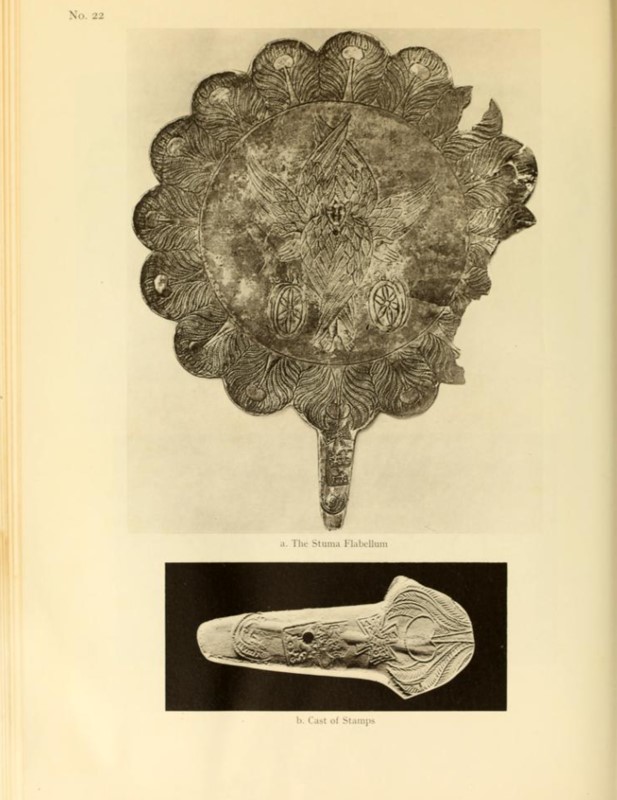
Stuma Flabellum. Picture credits Erica Cruikshank Dodds, Byzantine Silver stamps, Dumbarton Oakes research library and collection 1961, p 98
Another flabellum known as the ‘Riha flabellum’ belongs to Dumbarton Oaks collection with a date stamp indicating Emperor Justin II (565- 578 AD) engraved with peacock feathers around the rim, cherub the four-winged angel described in Ezekiel 1: 4-21 in the centre- four wings, hand and faces those of a man, lion, ox and an eagle, known as tetramorph[24].
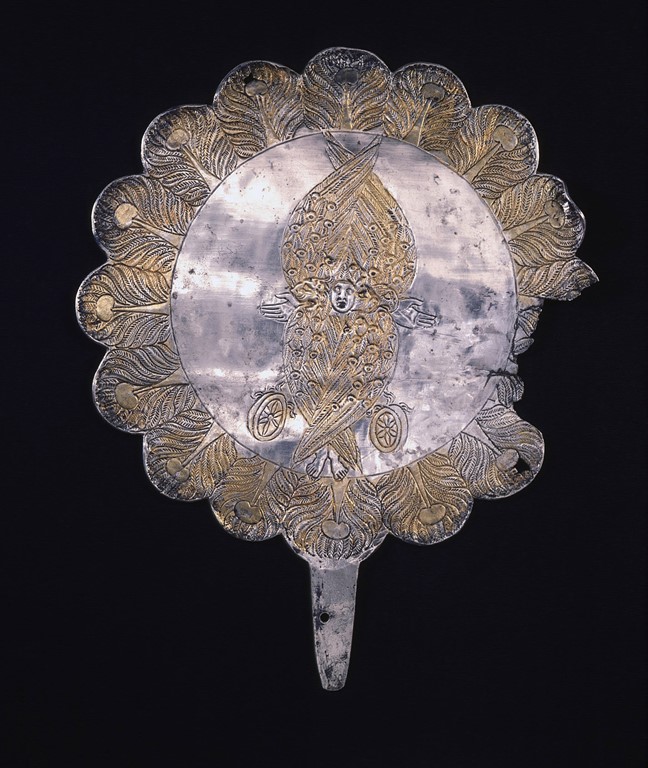
Riha Flabellum. Picture credits-http://museum.doaks.org/objects-1/info/27007 accessed on 03 Feb 2022
Symbolism
Liturgical fans were used initially for the practical purpose of driving the insects away from the Holy bread and wine during the celebration of the Holy Eucharistic liturgy. This was performed by the deacons. Later, due to theological development and subsequent theological explanations, these fans were symbolised as the wings of angels around the Holy Throne of God which is represented by the madbha in the church. The angels Seraphim serve at the throne chanting “Holy Holy Holy” all the time and flapping their wings over the Holy sacrifice. This explanation was based on the vision of Prophet Isaiah in Isiah 6: 2-7, where the Seraphim were standing above the throne of God chanting Holy Holy Holy, is the Lord of Hosts[25].
Pseudo Dionysius in De Ecclesiastica Hierarchia describes the deacons standing in the altar bearing the flapping fans or Maksaneethsa as the angel Seraphim[26]. The deacons holding the flapping fan symbolise the angels Seraphim and the Maksaneethsa represents the wings of seraphim. In the Greek tradition, it is also called hexapteryga means six-winged based on the symbolisation with six-winged seraphim[27].
One of the oldest extant flabellum, the ‘stuma flabellum’ in the Kaper Koraon treasure kept in the Archaeological Museum of Istambul, is engraved with a six-winged seraph and the ‘Riha flabellum’ of the Dumbarton Oaks collection is engraved with a Cherub, the four-winged angel as described in the vision of Ezechiel 1: 4-21[28].
East Syriac Father Narsai (390- 502 AD) symbolises the altar as the tomb of our Lord and the deacons serving in the altar as angels hovering and brandishing with fans[29].
In the Liturgical commentaries of Jacob of Edessa, (633-708 AD) the liturgical fans are symbolised as six-winged seraphim[30].
An anonymous author of the ninth century who wrote about the liturgical reforms of Patriarch Ishoyahb III comments the deacons who hold the liturgical fans symbolise seraphim who stood above the divine throne as Isaiah saw in his vision in Isiah 6:2[31]
Bar Cepha of the 8th century also compares these deacons to angels Cherubim and Seraphim[32].
In the commentary of George of Arbel, the deacons holding the maksaneethsa represent the Cherubim and the deacons carrying the lights represent the Seraphim[33].
Dionysius Bar Salibi symbolises the marwhoto or liturgical fan as Seraphim[34].
Based on this symbolisation, the image of six-winged seraphim is engraved on Maksaneethsa. Some extant flapping fans in the museums are engraved with four winged cherubim also[35].
Bishop Hilderbert of Le Mans and later Archbishop of Tours (French ecclesiastic, 1055-1133 AD) symbolises the flapping of Maksaneethsa in liturgy to drive away of banishing of temptations[36].
Symbol of Deaconate
Liturgical fans are symbols of the diaconate. The deacons use the Maksaneethsa in the liturgy. In the Byzantine rite, even today, after the ordination of a deacon, a rhipidion– liturgical fan is handed over to the deacon with his vestments by the consecrating bishop[37].
Narsai describes the deacons on the altar as Gabriel and Michael. The deacons in the altar officiate as watchers. They hold the fans on either side of the priest when he consecrates. They read scriptures, recite litanies etc. Gabriel is the functionary of the New Testament and Michael, of the Old Testament. Narsai depicts them as the two angels the disciples saw at the tomb of our Lord[38].
Maksaneethsa in The Syro Malabar Church
‘Alavattam[39]’, a flapping fan made of peacock feathers is used in Kerala state of South India both by Hindu temples and Christian Churches. Alavattam is still in use in ancient Thomas Christian Churches like Kuravilangadu, Aruvithura, Kaduthuruthy, Athirampuzha and so on, not in the liturgy but processions in an honorific manner. Liturgical use may have been suppressed by the Portuguese Missionaries as part of the suppression of the alleged heathen practices in churches, as these were widely used in Hindu Temples.
The Puthencoor faction of the Thomas Christians-those who adopted the Antiochene rite after the division of Coonan Cross oath- still use liturgical fan bells in their liturgy as these were reintroduced by their West Syriac prelates.
Flapping fan as a Liturgical ornament: in ancient manuscripts of the Western Church
Liturgical fans are widely used in Greek and Syriac liturgies. Flabellum was used in the services of the Roman Church in the very early period[40]. In the Latin West, it was widely used until the 14th century.
Apostolic Constitutions written in the 4th century AD narrates about two deacons on either side of the altar holding the fans.
John Moschus describes in his book Pratum Spirituale, which is a hagiographical story of Eastern Monks and hermits, narrates an Italian Bishop while offering the Holy Sacrifice in presence of Pope Agapitus (535-536 AD) requested the Pope to tell the deacon not to use the flabellum while the prayers of the offerings[41]. This suggests that flabellum or liturgical fan was in use in Rome.
In the Carmelite order, flabellum was used until recent times. The ordinal of Carmelite theologian Silbert De Beka (d 1332) gives rubrics about the usage of a flabellum. The rubrics in the ordinal of 1544 also mentions the usage of flabellum. In the ordinal of 1666, the usage of flabellum was permitted optional. In the ceremonial of 1906, variations in the usage are described in the appendix.[42] Archdale King reported that Carmelites in Ireland used flabellum in the 1950s as a ceremonial adjunct[43].
The oldest Dominican Missal also known as Paris Missal, of 1240 has an illustration in which the Priest is depicted at the altar assisted by a deacon waving a flabellum.[44]
A Hiberno Saxon manuscript of the Gospels of the 8th century at Trier in Germany depicts a flabellum on the right hand of Saint Mathew and the Book of Kells, the ancient 9th-century Irish manuscript featuring the four gospels shows angels bearing flabellum made of thin plates of metal surrounded by little bells[45].
Ceremonial processions
Liturgical fans are used in ceremonial processions for example procession of the relics of St Liborius in Paderborn and processions in Malta[46].
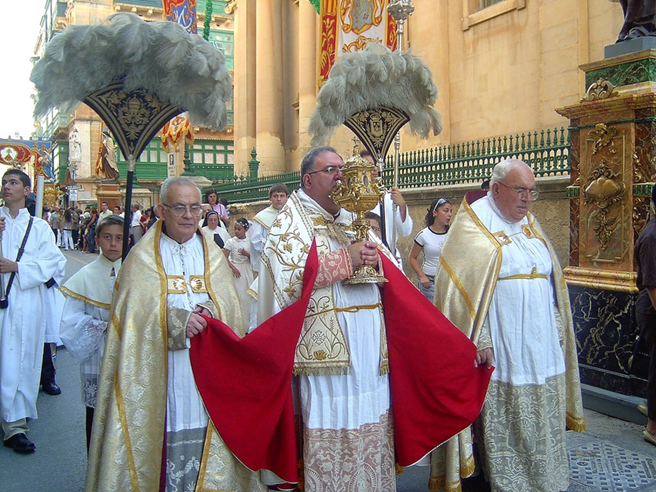
The liturgical fan in a procession in Malta. (Picture Credits to Shawn Tribe, A brief History of the Flabellum, Liturgical Arts Journal, July 3, 2018)
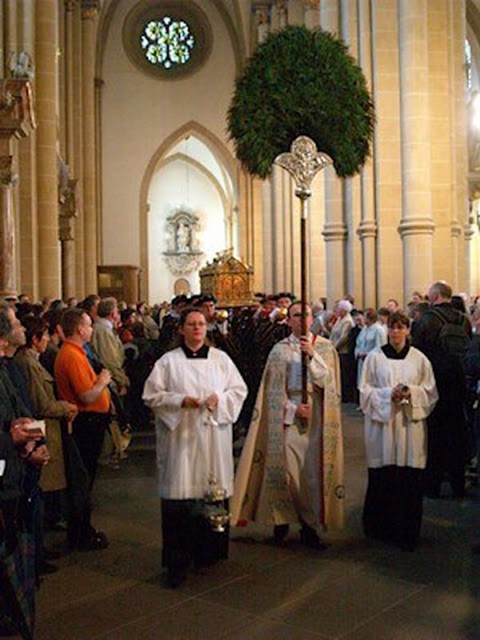
Use of liturgical fan in Paderborn. (Picture credits to Shawn Tribe, A brief History of the Flabellum, Liturgical Arts Journal, July 3, 2018)
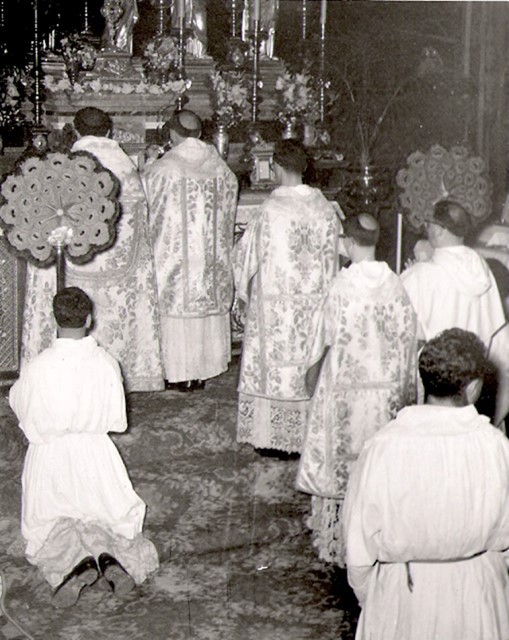
Use of Liturgical fan in Dominican Rite (Picture credits to Shawn Tribe, A brief History of the Flabellum, Liturgical Arts Journal, July 3, 2018)
Use of Liturgical fan in Western Church- Latin Church
Rome
In the ancient Basilica Santa Sabina of Rome, a liturgical fan is seen among those sacred instruments figured on the spandrels of the arches in the nave[47].
The liturgical fan was commonly used in the Roman Church and the western Christendom from the prayers of offertory till the end of the eucharistic prayers during the Middle Ages. Cluniac customary of Benedictine reforms of 10th century, Ordo Romanus XIV of 14 th century and Pontifical ceremonial of Pope Nicholas V (1447-1455AD) gives rubrics about the usage of fan at the time of flies[48]. Flabellum was used on the ceremonial processions of Popes at Saint Peter’s Basilica and Lateran Basilica in Rome until about 1978. Two of these fans are kept today in the museum of the University of Pennsylvania[49].
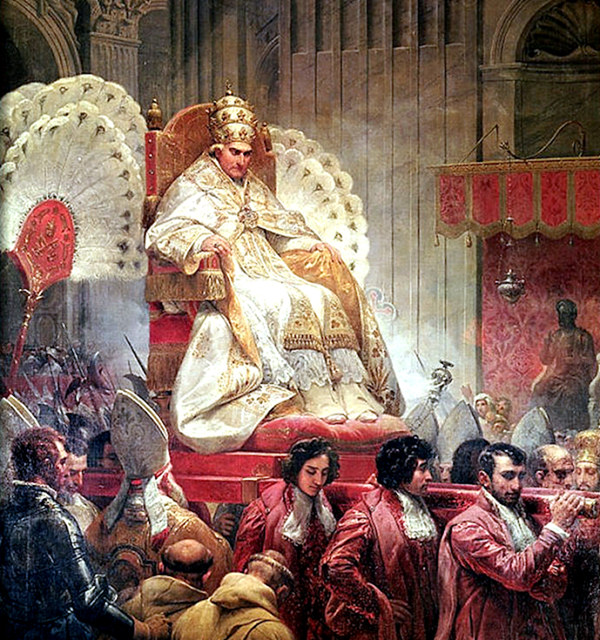
Ceremonial carrying of Pope Pius VIII into the St Peter Cathedral in 1829 (Picture credits to https://www.liturgicalartsjournal.com/2018/07/a-brief-history-of-flabellum.html accessed on 27/12/21)
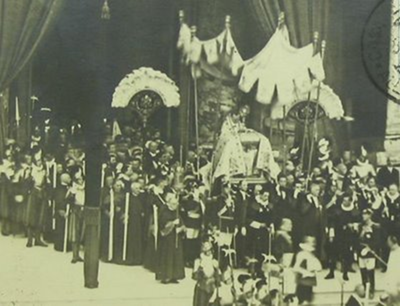
Procession of Pope Pius XI at Corpus Christi (Picture credits to http://morespaciousthantheheavens.blogspot.com/2010/11/fans.html)
Examples from ancient inventories in Europe
An inventory of the treasury of the Cathedral St Require church Abbeville in France narrates about a silver flabellum in 813 AD[50].
The Cathedral Church of Monza in Italy has a flabellum of the 7th-century[51] donated by Queen Theodolinda[52].
A ninth-century flabellum was preserved in Paris in the collection of M Carraud from the Abbey of Tournus, south of Chalons[53].
A silver flabellum is mentioned in the will of Everard, founder of the Abbey of Cysoing near Lille in France who died in 937 AD[54].
Inventory of Monastery of Amiens around AD 1300 had flabellum made of gold and silk “flabellum factum de serico et auro ad repellendas muscas”[55].
Inventory of Sainte Chapelle of Paris of 1363 mentions about two fans called muscalia ornamented with pearls[56] “item duo flabella vulgariter nuncupate muscalia, ornate perlis[57]”
Abbey of Kremsmunster in Austria has a very beautiful flabellum still preserved[58].
Examples from ancient inventories in England
Inventory of the treasury of Salisbury Cathedral in England taken in 1222 narrates one silver and 2 parchment flabellum[59].
A liturgical fan was used in the altar of All Hallows, Salve or Lady chapel in Salisbury cathedral dedicated on 28 September 1225. The inventory of 1314 mentions “ij flabella de serico et pergameno”[60].
St Paul’s Cathedral in London, the flabellum was made from feathers of the peacock.
In the inventory of 1298, the church of Saint Faith under Saint Paul’s Cathedral had a fan of peacock feathers. “unum muscatorium de pennis pavonum”[61]
York cathedral inventory mentions [62] John Newton, the treasurer of the Minster of York in 1400 donated a flabellum to the York Minster with silver gilt handle and silver flabellum with an image of the Bishop enamelled on it. “manubrium flabella argenteum deauratum, ex dono John Newton n cum ymagine episcopi in fine enamelled, pond v unc.[63]”
In 1346, Bishop Hanno donated to a chantry in Rochester Cathedral a silver fan with ivory handle[64]. “unum flabellum de serico cum virga eburnean[65][66]”.
Inventory of the property of Robert Bilton, Bishop of Exeter (1330) contains mentions of “flabellum de serico”[67].
The Walberswick (Suffolk) Churchwardens accounts for the year 1493 have an entry of a “bessume of pekok’s feathers[68]”.
Revival of Maksaneethsa in the Syro Malabar Church
There have been recent efforts in the revival of Maksaneethsa in Syro Malabar Church including the Archeparchies of Trichur, Changanacherry, Eparchies of Palai, Kanjirappalli and Great Britain.
Liturgical fans were widely used in England until the middle ages as evidenced by manuscripts and inventories. The Syro Malabar Eparchy of Great Britain was instrumental in the reintroduction of Maksaneethsa in England after a few centuries.

Reintroduction of Maksaneethsa after several centuries in England. St Michael’s Abbey, Farnborough, England, 4th of December 2021 by Mar Joseph Srampikkal in presence of the Apostolic Nuncio, Archbishop Cloudio Gugeroti. Picture credits Adarsh Kurian.
In the recent concluding celebration of the year of Saint Joseph 2020-21 at Saint Michaels’ Abbey Farnburough, England, the national shrine of Saint Joseph, on 4th December 2021, maksaneethsa was reintroduced in the English catholic Church by Mar Joseph Srampikkal, the Bishop of the Syro Malabar Eparchy of Great Britain in presence of the Apostolic Nuncio, Archbishop Cloudio Gugeroti. Farnbourough is very close to Salisbury Cathedral where Maksaneethsa was widely used in the liturgy evidenced by ancient manuscripts[69].
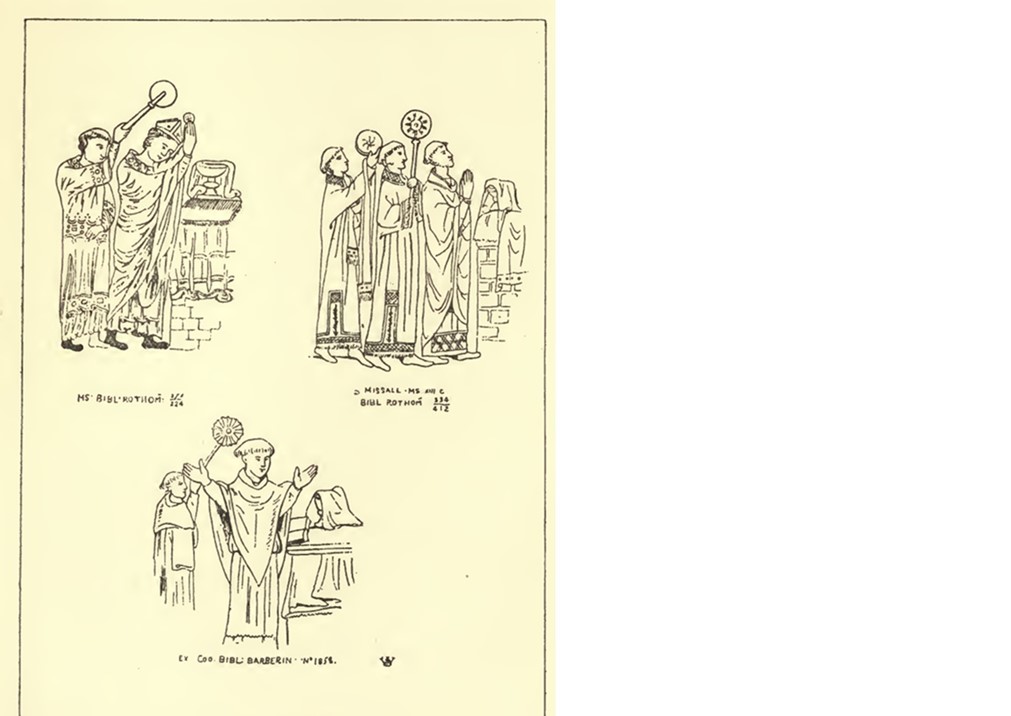
Usage of flabella, the liturgical fan, how it is held as shown in the ancient manuscripts Salisbury Cathedral, England. The picture was taken from Rock Daniel, The Church of our Fathers as seen in St Osmund’s rite for the cathedral of Salisbury: with dissertations on the belief and ritual in England before and after the coming of the Normans, London, J Murray publishers page 175
Maksaneethsa has now been regularly used in liturgy in Marth Alphonsa Cathedral at Preston of the Syro Malabar Eparchy.
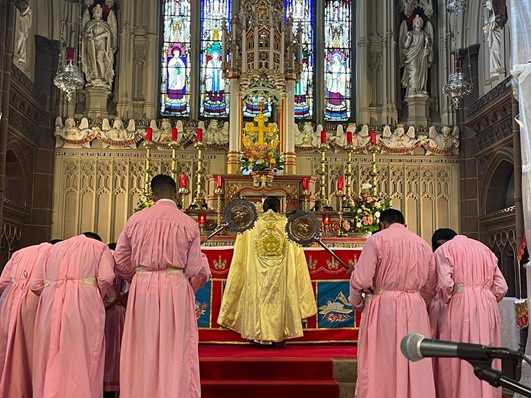
Maksaneethsa in use at Marth Alphonsa cathedral, Preston, England. Christmas ceremonies 2021 Picture and video credits Rev Fr Varghese Puthenpurackal, Cathedral Vicar, Marth Alphonsa Cathedral, Preston, England.
The Syro Malabar Eparchy of Great Britain is the only Bishopric in Syriac tradition based in Great Britain. The Syro Malabar Eparchy of Great Britain is actively promoting and witnessing spirituality in Syriac tradition among the diaspora community of Syro Malabar faithful and the native Catholics of the Roman Rite. Spirituality in Syriac tradition is not unknown to the Church in Great Britain. The Syriac influence of the illustrious Archbishop Theodore of Canterbury (668-690 AD) who was a Greek from Tarsus but was fluent in Syriac is well documented. The influence of Syriac exegetical literature is widely seen in the Biblical Commentaries of the Canterbury School of Theodore[70].
Conclusion.
Maksaneethsa is an ornament used in the Liturgy to show honour and adoration. It is an external expression of worship. It represents the Holy Angels Seraphim and Cherubim serving at the Madbha, the throne of God in the Divine Liturgy. The use of this Holy tradition was lost in the Western Church but still actively in use in the eastern Byzantine Churches and Syriac Orient. Being the only Eparchy of Syriac tradition in Great Britain, the Syro Malabar Eparchy has an important role among the English Catholics to witness the Judeo-Christian spirituality of the Apostles in its genuine purity and introduce the rich practices and rituals of the Syriac tradition.
Credits.
Thanks to Adarsh Kurian for the title picture taken on 04 Dec 2021 at Saint Michael’s Abbey, Farnborough, England
Thanks to Rev Fr Varghese Puthenpurackal, Vicar, Marth Alphonsa Cathedral, Preston, England
[1] Catholic Encyclopaedia refers ceremony in liturgy as an external action, gesture or movement which accompanies the prayers and public exercise of divine worship. Council of Trent session XXII, cap. V. adds that the things over which or with which the prayers are pronounced like blessings, lights, incense, vestments etc. Schulte, A.J. (1908). Ceremony. In The Catholic Encyclopaedia. New York: Robert Appleton Company. Retrieved January 9, 2022 from New Advent: http://www.newadvent.org/cathen/03538b.htm
[2] https://dictionary.cambridge.org/dictionary/english/worship accesses online on 07 January 2022
[3] Thomas Aquinas says (Contra Gentiles, III, cxix) he must pray God a twofold adoration, one spiritual which consists of the interior devotion of the soul, the other corporal which manifests itself in the outward form of worship by suitable gesture or action. Schulte, A.J. (1908). Ceremony. In The Catholic Encyclopedia. New York: Robert Appleton Company. Retrieved January 9, 2022 from New Advent: http://www.newadvent.org/cathen/03538b.htm
[4] Schulte, A.J. (1908). Ceremony. In The Catholic Encyclopedia. New York: Robert Appleton Company. Retrieved January 9, 2022 from New Advent: http://www.newadvent.org/cathen/03538b.htm
[5] Dom H Philibert Feasey, O S B, The Liturgical Fan, The Antiquary: London vol 37, Feb 1901: 42-44
[6] Zlatko Matic, On some questions of contemporary liturgical practice: Altar bell in the liturgy, in B Sijakovic, Ed., Ad Orientum: Essays from Serbian Theology today, Belgrade. Faculty of Orthodox theology 2019, p 352
[7] https://www.britannica.com/topic/flabellum accessed on 11/1/22
[8] https://www.collinsdictionary.com/dictionary/english/rhipidion accessed on 30 Jan 22
[9] http://www.assyrianlanguages.org/sureth/dosearch.php?searchkey=22922&language=id accessed on 13 Feb 2022
[10] Bas Snelders and Mat Immerzeel, The Thirteenth Century Flabellum from Deir-ai-Surian in the Muse Royal de Mariemont(Morlanwelz, Belgium), Eastern Christian Art I, 2004, p116
[11] Varghese, B, Dionysius Bar Salibi: Commentary on the Eucharist (translation) in Moran Etho 10, SEERI< Kottayam India June 1998, p 54
[12] Archdale Arthur King, Liturgies of the Catholic Religious Orders 1955, p 322
[13] Collins Dictionary https://www.collinsdictionary.com/dictionary/english/muscatorium accessed on 27/12/21
[14] R H Connoly, The Liturgical Homilies of Narsai translated into English, in J Armitage Robinson, Ed., Texts and Studies contributions to Biblical and Patristic Literature, vol VIII, Cambridge University Press, 1909, p 4 foot note 1
[15] Varghese, B, Dionysius Bar Salibi: Commentary on the Eucharist (translation) in Moran Etho 10, SEERI< Kottayam India June 1998, p 54
[16] Mershman, F. (1909). Flabellum. In The Catholic Encyclopedia. New York: Robert Appleton Company. Retrieved January 13, 2022 from New Advent: http://www.newadvent.org/cathen/06089a.htm
[17] Bas Snelders and Mat Immerzeel, The thirteenth century flabellum from Deir ai- Surian in the Musee Royal de Mariemont (Morlanwelz, Belgium), Eastern Christian Art, 1, 2004, p 113-139
[18] Bas Snelders and Mat Immerzeel, The thirteenth century flabellum from Deir ai- Surian in the Musee Royal de Mariemont (Morlanwelz, Belgium), Eastern Christian Art, 1, 2004, p 113-139
[19] Dom H Philibert Feasey, O S B, The Liturgical Fan, The Antiquary: London vol 37, Feb 1901: 42-44
[20] Bas Snelders and Mat Immerzeel, The Thirteenth Century Flabellum from Deir-ai-Surian in the MuseeRoyal de Mariemont(Morlanwelz, Belgium), Eastern Christian Art I, 2004, p116
[21] Kaper Koraon treasure is a Byzentine silver treasure consisting of 56 individual items originating from Syria in the 6th and 7th centuries. Bas Snelders and Mat Immerzeel, The Thirteenth Century Flabellum from Deir-ai-Surian in the MuseeRoyal de Mariemont(Morlanwelz, Belgium), Eastern Christian Art I, 2004, p 116
[22] Bas Snelders and Mat Immerzeel, The Thirteenth Century Flabellum from Deir-ai-Surian in the MuseeRoyal de Mariemont(Morlanwelz, Belgium), Eastern Christian Art I, 2004, p 116
[23] Timothy Greenwood, A Corpus of Early Medieval Armenian Silver, in Dumbarton Oaks papers, Vol 69, 2015, p 142p
[24] http://museum.doaks.org/objects-1/info/27007 accessed on 03/02/22
[25] Is 6:1-3 from Goerge M Lamza, Holy Bible from the ancient Eastern text, Aramaic Peshitha English translation. Harper Collins publications, p704
[26] Bas Snelders and Mat Immerzeel, The thirteenth century flabellum from Deir ai- Surian in the Musee Royal de Mariemont (Morlanwelz, Belgium), Eastern Christian Art, 1, 2004, p 113-139
[27] http://morespaciousthantheheavens.blogspot.com/2010/11/fans.html accessed on 25/12/21
[28] Bas Snelders and Mat Immerzeel, The thirteenth century flabellum from Deir ai- Surian in the Musee Royal de Mariemont (Morlanwelz, Belgium), Eastern Christian Art, 1, 2004, p 116
[29] R H Connoly, The Liturgical Homilies of Narsai translated into English, in J Armitage Robinson, Ed., Texts and Studies contributions to Biblical and Patristic Literature, vol VIII, Cambridge University Press, 1909, p 4
Francis Kanichikkattil, Divine Liturgy, 2003, Dharmaram publications, p 95
[30] Varghese, B, West Syrian Commentaries on the Eucharist, Journal of Eastern Christian Studies 2004, vol 56, issues 1-4, p 281-282
[31] Francis Pittappillil, Baptismal memra of Anonymous author of the Nineth century, Liturgia sacra, 24, 2018, nr 1 s 71-91
[32] William Cornelis Unnick, Nestorian Questions on the Eucharist p 266
[33] Robert Matheus (Ed.), R H Connolly (Tr.) A commentary on the Mass (which has been attributed to, but it is not really) by the Nestorian George, Bishop of Mosul and Arbel (10th century) OIRSI , Kottaym , India 200 p 90
[34] Baby Varghese, Dionysius bar Salibi: Commentary on the Eucharist, Moran Etho, SEERI, Kottayam, 1998, p23, 54
[35] Bas Snelders and Mat Immerzeel, The thirteenth century flabellum from Deir ai- Surian in the Musee Royal de Mariemont (Morlanwelz, Belgium), Eastern Christian Art, 1, 2004, p 116
[36] Rock Daniel, The Church of our Fathers as seen in St Osmund’s rite for the cathedral of Salisbury: with dissertations on the belief and ritual in England before and after the coming of the normans, London, J Murray publishers p232 citing Epistle of Hilderbert I, 2(P.I. clxxi.143)
[37] Rock Daniel, The Church of our Fathers as seen in St Osmund’s rite for the cathedral of Salisbury: with dissertations on the belief and ritual in England before and after the coming of the normans, London, J Murray publishers,
Dom H Philibert Feasey, The Liturgical fan, The Antiquary: London vol 37, Feb 1901: 43, Archdale King, Liturgies of the Catholic Religious Orders 1955, p 322
[38] William Cornelis Unnick, Nestorian Questions on the Eucharist p 267, 178
[39] https://en.wikipedia.org/wiki/Aalavattam accessed on 09 January 2022. Alavattam is a special decorative circular shield or fan that is held beneath both sides of respectable idols , deities or mythological characters during festivals and dances especially in the state of Kerala in South India. .It is made of cut peacock feathers aligned in a circular fashion
[40] A. W. (1848) Notices of Ancient Ornaments and Appliances of Sacred Use, Archaeological Journal, 5:1, 201-206, DOI: 10.1080/00665983.1848.10850695
[41] Archdale King, Liturgies of the Catholic Religious Orders 1955, p 321
[42] Archdale King, Liturgies of the Catholic Religious Orders 1955, p 290
[43] Archdale King, Liturgies of the Catholic Religious Orders 1955, p 290
[44] Archdale King, Liturgies of the Catholic Religious Orders 1955 p 374
[45] Frederick Edward Warren, The Liturgy and Ritual of the Celtic Church p 144
[46] Shawn Tribe, A brief History of the Flabellum, Liturgical Arts Journal, July 3, 2018, accessed on 25/12/21https://www.liturgicalartsjournal.com/2018/07/a-brief-history-of-flabellum.html
[47] Rock Daniel, The Church of our Fathers as seen in St Osmund’s rite for the cathedral of Salisbury: with dissertations on the belief and ritual in England before and after the coming of the normans, London, J Murray publishers p 232
[48] Archdale King, Liturgies of the Catholic Religious Orders 1955, p 321-322
[49] Archdale King, Liturgy of the Roman Church, p 159
[50] Archdale King, Liturgies of the Catholic Religious Orders 1955, p 322
[51] Archdale King, Liturgies of the Catholic Religious Orders 1955, p 322
[52] Dom H Philibert Feasey, The Liturgical fan, The Antiquary: London vol 37, Feb 1901: p 43
[53] Dom H Philibert Feasey, The Liturgical fan, The Antiquary: London vol 37, Feb 1901: p 43
[54] Archdale King, Liturgies of the Catholic Religious Orders 1955, p 322
[55] Dom H Philibert Feasey, The Liturgical fan, The Antiquary: London vol 37, Feb 1901: p 43
[56] Archdale King, Liturgies of the Catholic Religious Orders 1955, p 322
[57] Dom H Philibert Feasey, The Liturgical fan, The Antiquary: London vol 37, Feb 1901: p 43
[58] Archdale King, Liturgies of the Catholic Religious Orders 1955, p 322
[59] Archdale King, Liturgies of the Catholic Religious Orders 1955, p 322
[60] Dom H Philibert Feasey, The Liturgical fan, The Antiquary: London vol 37, Feb 1901: 42
[61] Dom H Philibert Feasey, The Liturgical fan, The Antiquary: London vol 37, Feb 1901: 42-44
[62] Rock Daniel, The Church of our Fathers as seen in St Osmund’s rite for the cathedral of Salisbury: with dissertations on the belief and ritual in England before and after the coming of the normans, London, J Murray publishers p 233
[63] Dom H Philibert Feasey, The Liturgical fan, The Antiquary: London vol 37, Feb 1901: p 42, Archdale King, Liturgies of the Catholic Religious Orders 1955, p 322
[64] Archdale King, Liturgies of the Catholic Religious Orders 1955, p 322
[65] Dom H Philibert Feasey, The Liturgical fan, The Antiquary: London vol 37, Feb 1901: p 42
[66] Rock Daniel, The Church of our Fathers as seen in St Osmund’s rite for the cathedral of Salisbury: with dissertations on the belief and ritual in England before and after the coming of the normans, London, J Murray publishers p 233
[67] Dom H Philibert Feasey, The Liturgical fan, The Antiquary: London vol 37, Feb 1901: p 42
[68] Dom H Philibert Feasey, The Liturgical fan, The Antiquary: London vol 37, Feb 1901: p 42
[69] Rock Daniel, The Church of our Fathers as seen in St Osmund’s rite for the cathedral of Salisbury: with dissertations on the belief and ritual in England before and after the coming of the normans, London, J Murray publishers p 225
[70] Sebastian Brock, St Theodore of Canterbury, and the Canterbury school and the Christian east, Heythorpe Journal, XXXVI, 1995, p 433


Where in Trichur eparchy was it reintroduced?
It was used in Our Lady of Carmel Church, Enammackal by Fr. Francis Neelankavil.
https://fb.watch/bbuhiSqfzX/